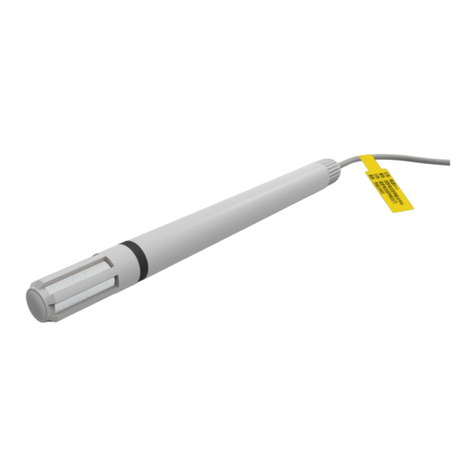
Moreover, when the measurement frequency is too
high, the temperature of the sensor itself will rise,
which will affect the measurement accuracy. In order
to make its temperature rise below 0.1℃, the
activation time of AHT10 should not exceed 10% of
the measurement time - it is recommended to
measure data every 2 seconds.
2.5Material used for sealing and encapsulation
Many materials absorb moisture and act as buffer,
which will increase response time and hysteresis.
Therefore, the material around the sensor should be
carefully selected. Recommended materials are:
metal materials, LCP, POM (Delrin), PTFE (Teflon),
PE, PEEK, PP, PB, PPS, PSU, PVDF, and PVF.
Material for sealing and bonding (conservative
recommendation): It is recommended to use method
of filling epoxy resin or silicone resin for packaging
electronic components. Gases released from these
materials may also contaminate AHT10 (see 2.2).
Therefore, the sensor should be finally assembled
and placed in a well-ventilated place, or dried for
24 hours in an environment of > 50℃, in order to
release the contaminated gas before packaging.
2.6Wiring rules and signal integrity
If SCL and SDA signal lines are parallel and very
close to each other, they may cause signal crosstalk
and communication failure. The solution is to place
VDD and/or GND between the two signal lines,
separate the signal lines and use shielded cables. In
addition, reducing SCL frequency may also improve
the integrity of signal transmission. A 100 nF
decoupling capacitor must be added between the
power supply pin (VDD, GND) for smoothing. This
capacitor should be as close to the sensor as possible.
See the next chapter.
ASAIR®
5
/1 0
www.aosong.com Guangzhou Aosong Electronics Co.,Ltd. Tel:400-630-5378 Versior:V1.1
Therefore, it is recommended that the sensor be
stored in the original package including sealed
ESD bag, and meet the following conditions:
temperature range 10℃- 50℃(0 - 85℃ in a limited
time), humidity 20 - 60% RH (no ESD packaged
sensor). For sensors that have been removed
from the original package, we recommend that
they be stored in antistatic bags made of metal
PET / AL / CPE.
During production and transportation, sensors
should avoid exposure to high concentration of
chemical solvents and prolonged exposure.
Avoid exposure to volatile glue, adhesive tape,
stickers or volatile packaging materials, such
as foamed foil, foam material, etc. The production
area should be well ventilated.
2.3 Recovery processing
As mentioned above, if the sensor is exposed to
extreme working conditions or chemical vapor,
the reading will drift. It can be restored to the
calibration state by processing as follows.
Drying: Keep for 10 hours at 80 - 85℃ with the
humidity of more than 75 % RH.
Rehydration: Keep for 12 hours at 20 - 30℃with
the humidity of more than 75 % RH.10
2.4 Temperature Influence
The relative humidity of gases depends largely
on temperature. Therefore, when measuring
humidity, all sensors measuring the same humidity
should work at the same temperature as possible.
When testing, it is necessary to ensure that the
tested sensors and reference sensors are at the
same temperature, and then compare the humidity
readings.
If the sensor and the heating-prone electronic
components are placed on the same printing
circuit board, measures should be taken to
minimize the effect of heat transfer as far as
possible in the design of the circuit.
For example, to maintain good ventilation of the
shell, the copper coating of AHT10 and other
parts of the printed circuit board should be as
smallest as possible, or leave a gap between
them. (See Fig. 10)
Figure 10 AHT10 top view of printing circuit board. The design of
milling slit can minimize heat transfer.
1075 % RHIt can be easily generated from saturated Na Cl.
AHT10 Technical Manual





























